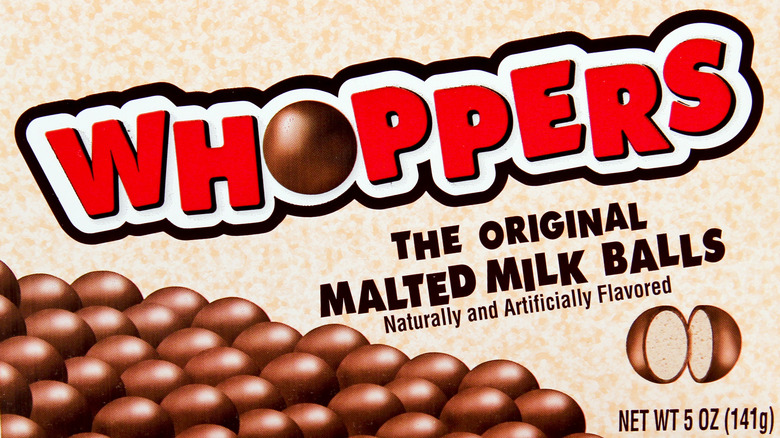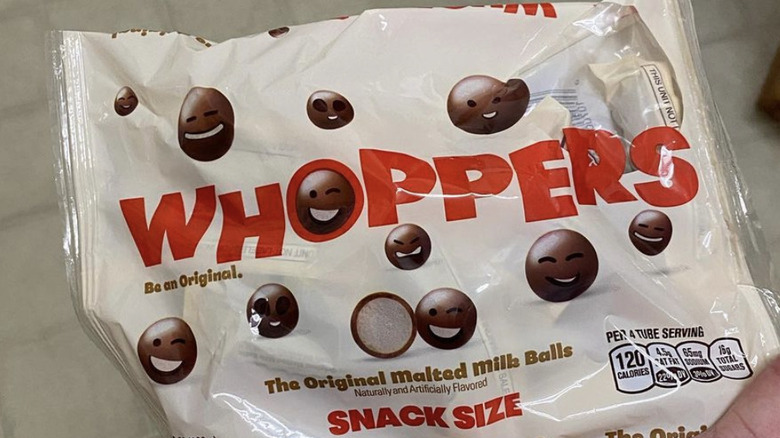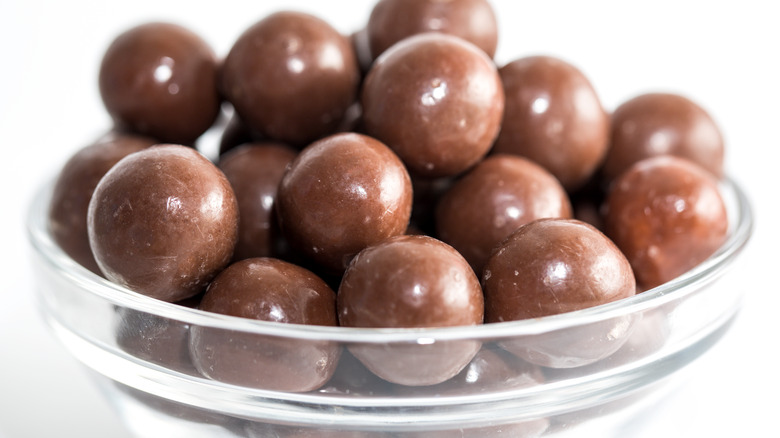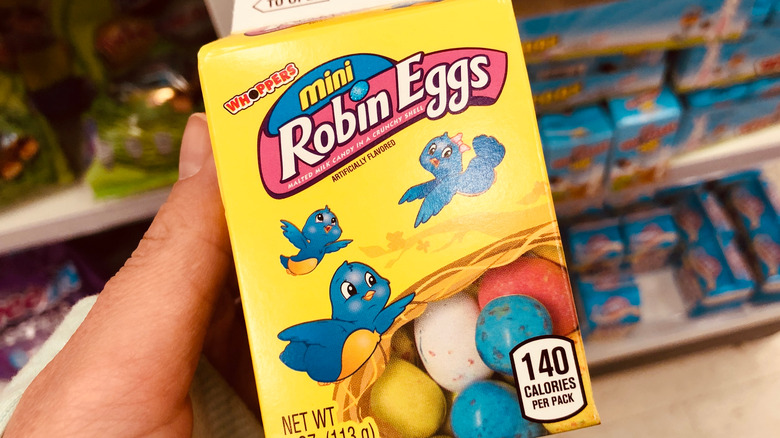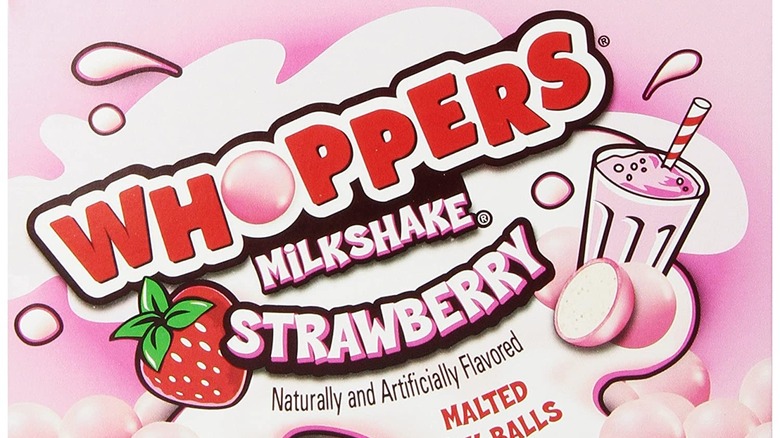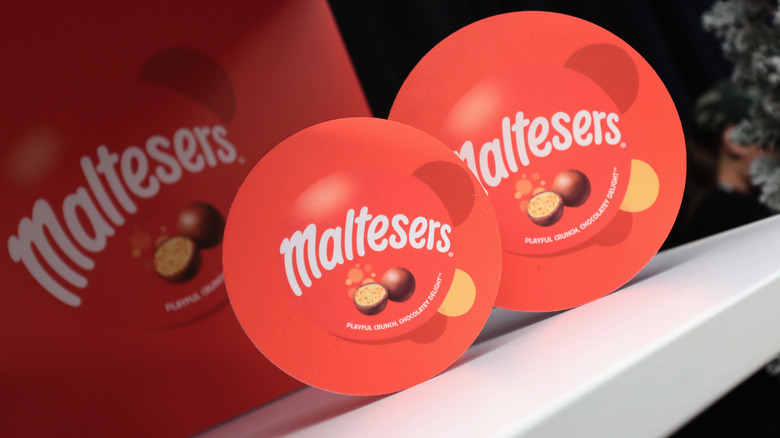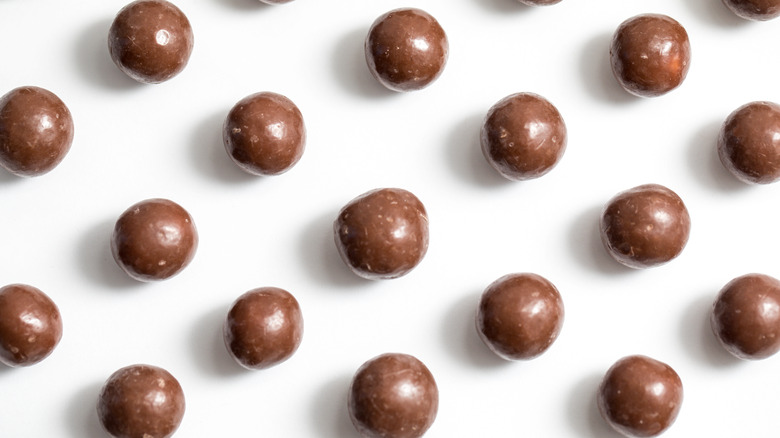The Untold Truth Of Whoppers
The candy racks at grocery stores, convenience stores, and gas stations are lousy with chocolate bars, but there aren't all that many bite-size chocolate candies out there. Besides solid chocolate M&M's and their peanut-based cousin, there are only a few other major players in the world of little chocolate pieces, and that includes Whoppers. The confection, sold in little beige bags and boxes, stands virtually alone in the crowded candy world as one of the few to use malted milk as its main ingredient. Plenty of candies are full of nuts and caramel; Whoppers are little more than rich, creamy chocolate covering a nugget of solidified malted milk, which is a combination of evaporated milk, processed barley, and wheat flour (the recipe was developed in the 1870s as a baby formula).
The history and impact of Whoppers is a colorful and dramatic story, which, like the candy itself, is a little bit sweet, has much to savor, and is at times unexpected. Here's the untold truth of Whoppers.
Whoppers have been made by lots of candy companies
Major candy bars are some of the most heavily marketed, and thus blatantly branded, food products in the world. For example, most people know the Crunch bar as "Nestle Crunch," or that Hershey's signature candy is its solid chocolate Hershey Bar. However, the connection between Whoppers and the identity of the candy company that produces them is complicated and has changed a lot over the years. The product we now know as Whoppers — little spheres of solid malted milk enrobed in chocolate — first became available in 1939 when they were produced by the Overland Candy Company, according to OldTimeCandy.com. Just eight years later, Overland was absorbed in a merger with the Chicago Biscuit Company, Leaf Gum, and Leaf Machinery, forming a new company called Leaf Brands, which dutifully produced Whoppers.
According to Snack History, W.R. Grace bought the production rights to all of Leaf's candy lines, including Whoppers, in the 1960s, but then the rights reverted back to Leaf in 1976. Finally, Hershey Foods bought Leaf North America in 1996 (via "The Oxford Companion to American Food and Drink"), bringing Whoppers under the famous Hershey's banner along with Milk Duds, Heath, and PayDay.
Whoppers used to have different names
Whoppers have been virtually the same product stretching back to their introduction in 1939. What's changed are the method in which they're sold and their name. According to Snack History, the chocolate-covered malted milk balls were originally offered loose and unwrapped (out of jars in candy shops) for the low price of two for 1 cent. At the time, they were on the larger side of bite-size candies, and thus, the Overland Candy Company called them Giants. After a few years, when automatic cellophane wrapping machines became inexpensive and efficient enough for industrial use, the candy became available in plastic tubes of five and known as Fivesomes (via Candyblog), likely a play on how manufacturer Leaf also made the candy Sixlets, which were sold in cellophane packs of six pieces.
Leaf would also introduce a line of M&Ms-sized malted milk balls called Malt-ettes. So it makes sense why, in the late 1940s, according to OldTimeCandy.com, they changed the name of their larger chocolate malt balls to Whoppers (which means "big").
Whoppers spawned one of the most popular holiday candies
Many major American holidays have a certain class of candy associated with the day's festivities. Halloween has its "fun size" bars; Valentine's Day candy is all about heart-shaped boxes of bonbons; and Easter means the arrival of Peeps, Cadbury Creme Eggs, and Robin's Eggs, speckled, pastel-colored, bite-sized eggs made of a sweet candy shell, chocolate, and malted milk. Those eggs are actually a variation of Whoppers, the industry leader in chocolate-covered malted-milk balls, and the idea to manufacture them was hatched sometime in the late 1940s or early 1950s. According to Delish, the original Robin's Eggs were a bit larger than they are presently, and they didn't come with that pastel coating. By the mid-1950s, Robin's Eggs had taken on their familiar colors and size.
Seasonal demand is so high for Robin's Eggs that Hershey's starts making them five months before Easter, "laying" 11 million pounds of eggs in that time, a rate of about 2 million individual candy eggs each hour. And unlike most other mass-produced chocolates, Robin's Eggs aren't made with pour-in molds, but a vacuum-based process that stretches the candy into its oblong form. In the end, and out of all those millions upon millions of Robin's Eggs, no two have the exact same speckle pattern.
Whoppers spinoffs have mostly flopped
It seems like anytime a candy takes hold in the collective culture and palate, it's not long before its manufacturer rolls out some spinoffs or brand extensions. For example, Twix begat Peanut Butter Twix, there's a white chocolate version of Reese's Peanut Butter Cups, and Snickers Almond swaps out the peanuts for a different nut. With the exception of the annual rollout of Robin's Eggs, Whoppers does not rank among those successfully replicated candy brands, perhaps because the distinctive yeasty taste and grainy texture of its showcase ingredient, malted milk, doesn't pair well with things besides, or in addition to, chocolate.
Among the Whoppers varieties that failed to take hold: In the mid-2000s, Whoppers Milkshake Strawberry hit shelves, with a white, strawberry ice cream-suggesting covering over the malted milk instead of chocolate, as did Whoppers Reese's Peanut Butter Flavored Candy, which subbed out the chocolate for a sweetened nutty coat. Made special for the Easter season in 2009, three other "Whoppers Milkshake" flavors came and went: Vanilla, Blueberry, and Orange Creme (via Collecting Candy). Around this time, Whoppers also made a cameo appearance in a Hershey's line called TwoSomes which consisted of a regular Hershey Bar studded with tiny Whoppers candies (via Candyblog). Hershey's is hoping their luck will change with the upcoming holiday release of Whoppers Snowballs.
There's a lot of confusion between Whoppers and Maltesers
Franklin Mars of Mars Inc., (the company that makes M&M's and Snickers) didn't want to take his company international, but his son and fellow Mars executive Forrest Mars did, so the younger man went to Europe in the 1930s to pursue his fortunes. He started his own candy company in England, according to The Guardian, and among his products was a bite-sized, chocolate-covered malted milk ball sold by the bag called Maltesers. According to Candyblog, Maltesers arrived in stores in the U.K. in 1937 — two years before the Overland Candy Company started making chocolate-covered malted milk balls called Giants, later to be rebranded as Whoppers.
Maltesers grew to become one of the U.K.'s most popular candies, and they can be found as an import item in specialty stores in the United States. However, in the U.S., Whoppers producer Hershey's actually owns the American trademark on the word "Malteser," according to Confectionary News. This means that not only does Hershey's make Whoppers, an imitation of the original Maltesers from England, but they also produce a chocolate-covered malted-milk ball candy called Maltesers which are not related whatsoever to the imported British version.
A man sued Hershey's over half-empty Whoppers boxes
It can be disappointing, if not annoying, when one buys a packaged food product and opens it up to find that there isn't nearly as much of the delicious snack or candy inside as previously assumed. According to Consumerist, that empty space is called "slack fill," and sometimes it has a practical purpose, like how the air in a potato chip bag prevents breakage during transport. But according to Robert Bratton, who filed a legal complaint against Hershey's in 2017, the emptiness he incurred in boxes of Whoppers and Reese's Pieces went way beyond slack fill and constituted a kind of fraud. According to Bratton, the Whoppers box consisted of 41 percent air, which wasn't necessary to protect the candy because it came packaged in a plastic bag inside of the cardboard. In a statement in response to the suit, Hershey's said that "It is not possible to view the product packaging without also seeing the net weight and quantity disclosures."
A federal judge allowed the case to move forward, but in May 2018, according to Legal Newsline, U.S. District Judge Nanette K. Laughrey dismissed it, in part because Bratton kept buying Whoppers. "Mr. Bratton has admitted that, since well before the class period, he has been aware of approximately how much candy and how much empty space was in each box of Whoppers and Reese's Pieces, and that he nonetheless continued to purchase the boxes," Judge Laughrey said in her ruling.
